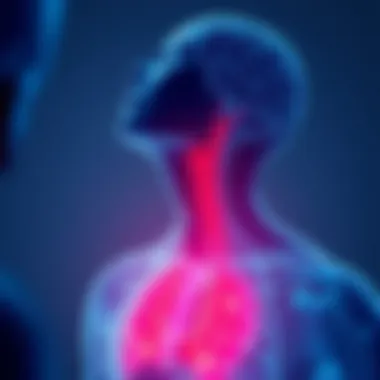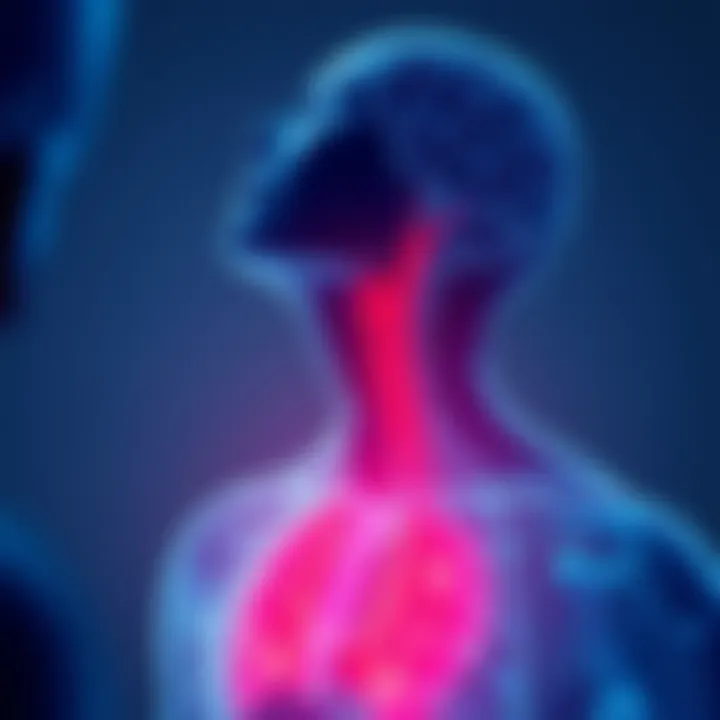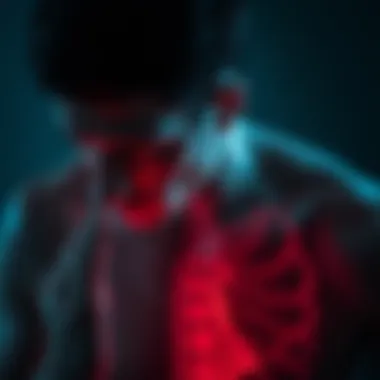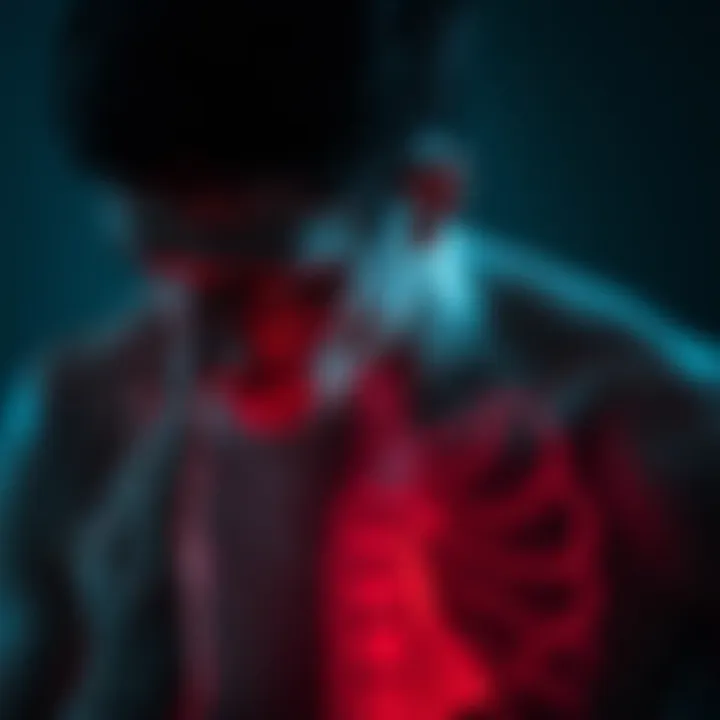Understanding the Link Between Anxiety and Chest Pain


Intro
The connection between severe anxiety and physical symptoms, such as chest pain, can often leave individuals feeling confused and worried. It’s not just a mental battle; anxiety can indeed manifest in ways that affect the body, leading to discomfort and even fear of heart-related issues. Understanding this complex relationship is crucial, especially for those navigating these distressing experiences.
Understanding Mental Health and Well-being
What is Mental Health?
Mental health is more than just the absence of mental illness. It encompasses emotional, psychological, and social well-being. It's about how we think, feel, and act in daily life. When mental health is prioritized, individuals tend to have better coping abilities in the face of stress, leading to a more balanced life.
The Importance of Prioritizing Mental Well-being
Putting mental well-being at the forefront is vital for a number of reasons. Mental health directly influences how we handle stress, make decisions, and relate to others. Furthermore, good mental health enhances overall happiness, productivity, and quality of life. It’s a cornerstone that supports all aspects of life. Ignoring it can lead to a chain reaction affecting physical health, including heart health.
Common Mental Health Challenges and Disorders
The landscape of mental health is vast. Conditions such as depression, anxiety disorders, and PTSD are just a few examples that many face. Anxiety, particularly, is a silent storm that can unveil itself in various forms, like panic attacks. These attacks can trigger the fight or flight response, leading to physical sensations, such as chest pain.
Strategies for Improving Mental Health
Self-care Techniques and Practices
Self-care should not be deemed as self-indulgent; rather, it's a necessary practice. Prioritizing time for personal well-being can look like:
- Engaging in hobbies or activities that bring joy.
- Setting aside time for relaxation, like reading or taking a warm bath.
- Journaling thoughts and feelings to gain clarity.
Building Resilience and Stress Management
Resilience is the ability to bounce back from challenges. This can be cultivated through understanding one's triggers and developing coping mechanisms. Techniques such as cognitive restructuring can help transform negative thoughts into more realistic ones, providing clarity during moments of distress.
Seeking Professional Help: Therapy and Counseling
When it becomes overwhelming, reaching out for professional help is important. Therapists, especially those trained in cognitive-behavioral therapy, can provide tools and strategies tailored to individual needs. Don’t hesitate; it’s a sign of strength to seek help.
Finding Balance in Life
Healthy Lifestyle Choices: Diet, Exercise, and Sleep
Maintaining a balanced lifestyle is about making choices that benefit the mind and body. Regular exercise can reduce stress and improve mood, while a nutritious diet supports mental health. Quality sleep is non-negotiable; it’s the body’s way of resetting and healing.
Mindfulness and Meditation Practices
Incorporating mindfulness and meditation can develop a deeper awareness of one’s thoughts and feelings without judgment. Simple practices like focused breathing or guided imagery can help in managing anxiety episodes and reducing physical symptoms such as chest pain.
Setting Boundaries and Managing Time Effectively
Learning to say no is powerful in avoiding burnout. Effective time management allows for priorities to be addressed without overwhelming oneself. Balance is about knowing when to step back. It helps create a clearer mind and a healthier emotional state.
Enhancing Personal Development
Goal Setting and Productivity Tips
Setting realistic goals can foster a sense of accomplishment. Break larger tasks into manageable steps, which can prevent feelings of being overwhelmed.
Building Healthy Relationships and Social Connections
Social support is essential. Engaging in meaningful relationships can provide comfort and lessen feelings of isolation. Prioritize connections that uplift rather than drain energy.
Practicing Gratitude and Positivity
Cultivating an attitude of gratitude can shift focus from negative aspects to positive ones. Keeping a gratitude journal is a simple yet powerful way to remind oneself of the good amidst challenges.
Tips for Maintaining Mental Well-being
Strategies for Preventing Burnout
Preventing burnout starts with recognizing the signs. Take breaks when needed, and don’t stretch oneself too thin in commitments.
Coping with Challenges and Setbacks
Life is not without its bumps. Developing a toolkit of coping strategies can empower individuals to face setbacks with resilience. This might include reaching out for support, practicing self-compassion, or engaging in physical activity to release pent-up stress.
Creating a Supportive Environment


Lastly, creating an environment that promotes mental wellness is crucial. Surround oneself with positivity and may be decluttering both physical and emotional spaces can lead to a clearer mind.
"Caring for your mental health is not just about treatment; it's about creating a life where you can thrive."
For further insights on managing mental health and anxiety, consider visiting reputable resources like MentalHealth.gov and National Institute of Mental Health. These platforms offer tools and information that can guide individuals towards better mental health.
Understanding Anxiety
Anxiety is a multi-faceted phenomenon that goes beyond just feeling nervous before a big presentation or a first date. It is an emotional state that can affect the way we think, feel, and even how we behave in various situations. Grasping the intricacies of anxiety is crucial in understanding its connection with physical symptoms like chest pain. A deeper comprehension not only aids individuals in navigating their feelings but can also empower them to seek appropriate resources and strategies to cope with their anxiety.
Definition of Severe Anxiety
When we talk about severe anxiety, we are referring to an intense and often overwhelming sense of dread or worry that can significantly interfere with daily life. Unlike general feelings of anxiety that might arise in stress-inducing situations, severe anxiety can be a consistent and persistent experience. It’s the kind of feeling that might keep someone up at night, churning over thoughts while their heart races, and they feel trapped in a cycle of fear. This state can lead to physical manifestations, including muscle tension and chest discomfort, making it vital to recognize and differentiate.
Common Symptoms of Anxiety Disorders
Anxiety can manifest in numerous ways. Some of the most common symptoms include:
- Restlessness: An inability to relax, often accompanied by an unsettled feeling.
- Fatigue: Constantly feeling tired even after a good night’s sleep.
- Concentration Issues: Difficulty focusing or completing tasks due to racing thoughts.
- Physical Symptoms: This could range from headaches to sweating, and most notably, the feeling of tightness in the chest.
These symptoms can make daily life a challenge, as individuals might find themselves trying to manage an internal storm that doesn’t seem to settle.
Different Forms of Anxiety
The landscape of anxiety disorders is diverse, with each form having its unique characteristics and implications. Here are some of the most prevalent types:
Generalized Anxiety Disorder
Generalized Anxiety Disorder (GAD) is marked by excessive worry about various aspects of life such as work, health, and everyday tasks. People with GAD often feel like they are on a lifelong rollercoaster ride of anxiety without a clear destination. One might say it’s like carrying a heavy load that gets heavier every day, filled with worries that often do not have a concrete basis. This unwarranted apprehension is key in understanding how GAD contributes to physical issues like chest pain – the body often reacts to this sustained panic with stress responses that can lead to discomfort.
Panic Disorder
Panic Disorder presents a different flavor of anxiety, often characterized by sudden and intense waves of fear. Individuals might experience panic attacks where they feel overwhelmed, short of breath, or even as if their heart is going to explode. It’s notable how these attacks can mimic cardiac events, leaving a person questioning whether they are experiencing heart trouble or simply a panic episode. This distinguishes Panic Disorder, as it can lead to avoidance behaviors, where one shuns environments or activities for fear of triggering another episode.
Social Anxiety Disorder
Social Anxiety Disorder is often overlooked but is significant in the conversation about anxiety. It involves intense fear in social situations, leading to avoidance that can severely limit life experiences. The unique aspect here is the fear of judgment, which can cause profound distress. For those struggling with this disorder, everyday situations like asking a question in class or engaging in small talk can feel like climbing Everest. The link to physical symptoms, including chest tightness, lies in the stress that arises from these social situations, amplifying feelings of anxiety and distress.
Understanding these different types of anxiety is crucial for recognizing the broader implications they can have, not just mentally but physically as well. Each type carries its unique set of challenges and can contribute to the complex relationship between anxiety and physical symptoms like chest pain.
The Physical Impact of Anxiety
Understanding how severe anxiety affects the body is crucial in grasping the connection between mental health and physical symptoms. When we talk about the physical impact of anxiety, we’re not just scratching the surface here; it dives deeper into the way anxiety can manifest through various bodily reactions. These responses are often involuntary and can linger long after a stressful event has passed. Recognizing these reactions helps individuals to navigate their experiences more adeptly, allowing them to approach their symptoms with greater awareness.
The body and mind operate as a unit, and when one starts to struggle, the other often follows suit. Thus, being attuned to how anxiety affects your physical state becomes imperative. Knowing these impacts not only validates the experiences of those living with anxiety but can also lead to effective coping mechanisms. As we'll later explore, the discomfort stemming from anxiety is very real and should not be overlooked as mere psychological whining, but instead, be treated with the seriousness it deserves.
Psychosomatic Symptoms
Psychosomatic symptoms, which arise when stress influences bodily functions, can lead to a plethora of physical issues. The connection between the mind and body is not merely philosophical—it manifests in tangible symptoms. When anxiety hits, the effects can trigger headaches, stomach problems, or, as we are particularly focused on here, chest pain. For instance, a person might find themselves experiencing tightness in their chest during a stressful situation or panic attack. This discomfort can blur the lines and often scares individuals into thinking they're facing a heart problem.
Factors like stress can cause muscle tension across various parts of the body. When that tension gathers around the chest area, it can lead to sensations that mimic heart-related issues, even though they stem from anxiety. Here are a few common psychosomatic symptoms:
- Chest pain or discomfort
- Gastrointestinal issues, including bloating or nausea
- Persistent headaches
- Increased heartbeat
- Fatigue
These symptoms may vary by individual, but the commonality lies in their psychogenic origins.
“Symptoms of severe anxiety can feel like a freight train hitting you, where an anxious mind meets a susceptible body.”
Moreover, these reactions do not develop in isolation; they circulate and can even compound one another. For instance, when a person experiences chest pain, this can lead to further anxiety about their health, which in turn can worsen the initial pain and lead to a vicious cycle.
Mind-Body Connection
The mind-body connection is often an overlooked aspect in discussions about anxiety. This connection serves as a bridge between psychological states and bodily responses. When stress or anxiety arises, the brain sends signals to the body, prompting various reactions. Consider it as an emergency alert system—it's meant to prepare the body for
Chest Pain: A Common Complaint
Chest pain is a topic that evokes significant concern among many individuals. It occupies a unique space in our collective consciousness, often leading to immediate worry about potential cardiac issues. However, in this discussion, we aim to shed light on how severe anxiety factors into this equation. The experience of chest pain can arise from various sources, both physical and psychological, making it crucial to dissect its origins including that of anxiety. For those who suffer from anxiety disorders, it's important to understand how their mental state can manifest as physical discomfort, leading to a tangled web of symptoms that may overwhelm their awareness of well-being.
This section seeks to address the commonality of chest pain among individuals, specifically how it interacts with anxiety. By delving into the nature of chest pain and distinguishing between cardiac and non-cardiac causes, we can better equip individuals to respond to their symptoms. Proper understanding lays the groundwork for effective coping strategies, ultimately fostering a healthier perspective on both mental and physical health.
Nature of Chest Pain
Chest pain can take on a variety of forms and sensations. Some may describe it as a dull ache, while others may equate it to a sharp or stabbing sensation. The variability in descriptions speaks to the subjective nature of pain itself; what one person feels may be entirely different for another. Anxiety often intensifies physical sensations, causing an over-reaction to even minor discomforts. For example, an individual who is already on edge regarding their health might interpret mild tightness in their chest as something far worse.
This highlighted connection between mental and physical experiences is pivotal. Certain factors common in anxiety, such as heightened sensitivity to bodily sensations, can compound feelings of chest discomfort. Increased heart rate, tingling, or pressure may appear alarming, yet the psychological roots of these sensations must be acknowledged. In essence, understanding the wide range of chest pain experiences helps clarify that not every pang or ache signals a dire emergency.


Differentiating Cardiac from Non-Cardiac Pain
Distinguishing between cardiac and non-cardiac chest pain is essential, especially for those living with anxiety. While it’s commonplace for people to fear the worst, knowing the symptoms that differentiate these kinds of pain can provide some level of reassurance. Here are a few points to consider:
- Cardiac Pain: This type often presents with:
- Non-Cardiac Pain: Anxious individuals may experience:
- Pressure, squeezing, or fullness in the center or left side of the chest
- Pain that radiates to the shoulders, neck, or jaw
- Accompanying symptoms like shortness of breath, sweating, or nausea
- Sharp, localized pain that doesn’t radiate
- Pain linked to specific movements or positions
- Recurrent pain that correlates with stress or anxiety episodes
Understanding these distinctions encourages individuals to evaluate their experiences more accurately rather than defaulting to panic. It’s essential to consult a medical professional when in doubt, as they can provide the most definitive assessments.
It's important to remember that self-evaluation has its limitations; seeking medical advice is always valid when chest pain arises.
Link Between Anxiety and Chest Pain
Understanding the relationship between anxiety and chest pain is crucial for anyone experiencing these distressing symptoms. It’s not just about the sensation of pain but rather the deeper implications it carries for mental and physical health. By recognizing the link between anxiety and chest discomfort, individuals can better address their symptoms and seek appropriate interventions.
A significant number of people suffer from chest pain linked to anxiety instead of actual heart problems. This section delves into various physiological mechanisms that underpin this relationship, as well as the psychological perspectives that help explain why anxiety manifests in such a physical way.
Physiological Mechanisms
Hyperventilation
Hyperventilation is when a person breathes more quickly and deeply than usual. This rapid breathing can lower carbon dioxide levels in your blood, which, oddly enough, can lead to sensations that feel like chest pain. One key characteristic of hyperventilation is that it often occurs in high-stress situations, making it a major player in anxiety-related chest discomfort. For this article, understanding hyperventilation is important because it illustrates how a simple act like breathing can have drastic physical repercussions when anxiety takes hold.
The unique feature of hyperventilation is that it can be both a symptom and a cause. It's beneficial for the article as it conveys the cyclical nature of anxiety — where anxiety causes hyperventilation, which in turn exacerbates feelings of anxiety. One downside, however, is the risk of misinterpreting these physical sensations as a heart issue, which may compel individuals to seek emergency treatment needlessly.
Muscle Tension
Muscle tension is another significant physiological aspect of anxiety. When people are anxious, their bodies tend to subconsciously tighten muscles, particularly in the chest, neck, and shoulders. This tightening can create or intensify feelings of tightness or pain in the chest area. This characteristic stands out because it demonstrates how our body responds to emotional stress.
The overwhelming sensation of muscle tension does an excellent job of highlighting the mind-body connection. Its unique feature lies in the fact that this tension can lead to further stress, perpetuating a cycle of discomfort. The advantage of recognizing this is that it opens up avenues for physical relaxation techniques, such as stretching or massage, as effective coping strategies, although it can sometimes be challenging to break the cycle.
Stress Hormones
Lastly, stress hormones such as cortisol and adrenaline play a pivotal role in this dynamic. When facing anxiety, the body releases these hormones, preparing itself for a 'fight or flight' response. The prime characteristic of stress hormones is their ability to heighten the body's senses, increasing heart rate and blood pressure, which can evoke sensations similar to chest pain. This concept serves well in this article as it showcases the biological underpinnings of anxiety-related symptoms.
The unique feature of stress hormones is that their presence is not just about feeling anxious; they signal to the body that something is seriously wrong, even when it might not be. This physiological response can lead to clarity in understanding why those experiencing anxiety feel significant physical discomfort. However, chronic elevation of these hormones can lead to detrimental health effects over time, making it essential to address anxiety holistically.
Psychological Perspectives
When diving into psychological perspectives, one must consider how thought patterns and emotional responses contribute to the perception of chest pain. Recognizing how fear and anticipation can amplify sensations helps in understanding the role of anxiety beyond just physiological mechanisms.
Cognitive distortions often fuel anxieties. Individuals may interpret minor aches or discomfort as catastrophic, leading to further anxiety and stress. Understanding these perspectives is key to developing coping strategies that can prevent the escalation of discomfort and promote better mental health. Whether through therapy or personal reflection, tackling these psychological elements can markedly improve overall well-being.
The connection between anxiety and chest pain is not merely psychological but deeply intertwined with our body’s natural responses to stress. Addressing both aspects is essential for comprehensive care.
Coping with Anxiety-Induced Chest Pain
When anxiety strikes, the body doesn’t hold back in expressing its turmoil, often leading to worries that physical discomfort such as chest pain may be a sign of a more serious health issue. This makes coping strategies essential for those experiencing anxiety-induced chest pain. Understanding and implementing these tactics can not only help alleviate symptoms but can also foster a more profound sense of well-being. Developing effective coping mechanisms is crucial for managing anxiety holistically, enabling individuals to reclaim their lives from the grasp of fear and discomfort. Here are some practical methods that can aid in navigating these challenging episodes.
Breathing Techniques
Breathing techniques serve as a foundational tool in the toolkit for battling anxiety. They offer a straightforward and immediate method to ground oneself during a panic or anxiety attack. Taking slow, deep breaths helps calm the nervous system, reducing the sensation of chest pain that often accompanies anxiety.
Here are some steps to follow:
- Sit or lie down in a comfortable position.
- Place one hand on your chest and the other on your abdomen.
- Inhale deeply through your nose, allowing your abdomen to rise as you fill your lungs. Focus on expanding your belly, not just your chest.
- Hold your breath for a count of four.
- Exhale slowly through your mouth, letting your belly sink back to its original position.
- Repeat this for several minutes.
Regular practice of these techniques not only wards off anxiety attacks but also promotes an overall sense of calm, which can be instrumental during distressing times.
Mindfulness Practices
Mindfulness involves focusing on the present moment, which can provide a much-needed reprieve when anxiety leads to overwhelming sensations in the body. Engaging in mindfulness practices can lessen the intensity of chest pain induced by anxiety, as it encourages individuals to observe rather than react to their feelings.
Methods to practice mindfulness include:
- Meditation: Spend a few minutes sitting quietly, focusing on your breath or a specific mantra. Let thoughts pass without judgment.
- Body Scan: Gradually focus on different body parts from head to toe, acknowledging any tension or discomfort without trying to change it.
- Grounding Techniques: Use your senses to anchor you in the present—notice the texture of an object, savor a piece of chocolate, or listen intently to sounds around you.
Integrating mindfulness into daily routines can significantly reduce anxiety levels over time, assisting individuals in managing both their mental and physical health effectively.
Cognitive Behavioral Strategies
Cognitive Behavioral Therapy (CBT) is one of the most evidence-based approaches for treating anxiety. The goal is to identify negative thought patterns and replace them with more balanced ones. By doing so, individuals can decrease the emotional response that leads to physical symptoms like chest pain.


Consider these strategies:
- Challenge Negative Thoughts: When you experience anxiety, take a moment to assess the thoughts you are having. Are they based on fact, or are they just assumptions? Replace them with positive affirmations.
- Exposure Therapy: Gradually expose yourself to anxiety-producing situations in a safe environment to desensitize your response.
- Behavioral Activation: Engage in activities you enjoy, as rewarding experiences can counteract feelings of anxiety and create positive associations.
Implementing these cognitive strategies can empower individuals to take the driver’s seat in their mental health journey, fostering resilience against anxiety-induced symptoms.
"The journey to managing anxiety is not a sprint, but a marathon. Each step taken is progress."
By addressing anxiety and its physical manifestations head-on, individuals can pave the way for enhanced emotional stability and improved quality of life.
Seeking Professional Help
When it comes to dealing with anxiety, especially in combination with physical symptoms like chest pain, seeking professional help can be a pivotal step toward healing. Many people often hesitate or think they can tough it out on their own, but addressing these issues head-on can bring about significant benefits.
First and foremost, consulting a medical professional offers clarity. Distinguishing between anxiety-induced chest pain and actual cardiac issues may be challenging for someone who is not trained. Making a trip to the doctor ensures a thorough evaluation, alleviating fears about potential heart problems. The knowledge that one is taking proactive steps can itself lessen anxiety. Health professionals have the tools and expertise to rule out serious conditions and can provide a clearer understanding of the symptoms being experienced.
Moreover, professionals can provide targeted treatment plans. Whether through medication, therapy, or lifestyle modifications, tailoring a program to fit the individual’s specific needs can yield results that self-help methods may not achieve. Additionally, having an expert on your side can foster a sense of accountability, encouraging adherence to treatment and lifestyle changes.
Beyond simply treating symptoms, mental health professionals play a crucial role. They can help unpack the emotional baggage that may contribute to anxiety. Engaging with a therapist offers a safe space to explore feelings and habits that might be leading to anxiety, and ultimately, chest pain.
In summary, seeking professional help is not just recommended; it's essential for grasping the situation comprehensively and taking informed steps towards managing both anxiety and its physical manifestations.
When to Consult a Doctor
Recognizing when to seek medical attention is a crucial step in managing severe anxiety and associated chest pain. If a person experiences chest pain that lasts longer than a few minutes, or if it occurs frequently, it should never be ignored. Here are some telltale signs that indicate it's time to consult a doctor:
- Persistent Chest Pain: If the pain doesn’t subside quickly or recurs, this may require immediate evaluation.
- Shortness of Breath: Feeling out of breath or experiencing difficulty breathing can complicate the symptoms and needs prompt medical attention.
- Dizziness or Lightheadedness: If anxiety seems to be causing dizziness, it could signal a more serious issue requiring assessment.
- Pain Radiating to Other Areas: Pain that spreads to the arm, back, neck, or jaw should be evaluated, as it can indicate cardiac issues.
- Accompanied Symptoms: Sweat, nausea, or feelings of impending doom at the same time as chest pain should always lead to a medical check-up.
Each of these warning signs can indicate underlying issues that need addressing. Anyone experiencing such symptoms should not hesitate to reach out to a healthcare provider for proper diagnosis and management.
Types of Mental Health Professionals
Navigating through mental health concerns may involve consulting various professionals, each specializing in different treatment methods. Here’s an overview of who may be helpful:
- Psychiatrists: Medical doctors specializing in mental health who can prescribe medication and provide therapy.
- Clinical Psychologists: Experts in therapy practices, focusing on assessing, diagnosing, and treating emotional and behavioral issues through talk therapy.
- Licensed Professional Counselors: Trained in various therapeutic techniques and can provide guidance focused on personal development and coping mechanisms.
- Psychiatric Nurse Practitioners: Nurses with advanced training who can both prescribe medications and offer therapy.
- Social Workers: Often provide therapy and can assist in connecting clients with community resources.
Each type of professional brings unique skills to the table, allowing individuals to choose based on their specific needs and preferences. Consulting with the right expert can enhance one's path to recovery, providing support and strategies that cater to personal experiences. It is a journey worth undertaking for the sake of mental health and overall well-being.
Personal Experience and Stories
When discussing severe anxiety and its physical implications, the narrative of personal experiences can shed light on the often-hidden struggles individuals face. The stories of those who have experienced anxiety-induced chest pain create a tapestry that illustrates emotional turmoil and the profound intersection of body and mind. Readers can find solace and connection through these firsthand accounts, realizing they are not isolated in their experiences.
Personal stories bring human context into what may otherwise feel like clinical or abstract information. By exploring the depths of individual experiences, we can better grasp the psychological complexities of anxiety.
Real-Life Case Studies
Consider the story of Sarah, a 28-year-old school teacher. Despite having no history of heart problems, she frequently found herself rushed to the emergency room, convinced she was having a heart attack. After several tests—including an EKG and a stress test—doctors determined her chest pains were not of cardiac origin but instead manifestations of her severe anxiety. This relief, however, was short-lived for Sarah, as she continued to struggle with panic attacks that would leave her breathless and tight in the chest.
Another case revolves around Mark, a 45-year-old accountant. He reported that during stressful work periods, he would often feel a tightening sensation in his chest, accompanied by rapid heartbeats and sweating. Initially dismissing these episodes as mere stress, he eventually learned to recognize them as anxiety-induced symptoms after documenting his experiences in a journal. Mark's openness to share these snapshots of his anxiety journey not only helped him process his feelings but also encouraged others to confront their emotional struggles rather than ignore or dismiss them.
These narratives help highlight the gap between self-perception and clinical understanding. They reveal how anxiety can cloud judgment and trick one’s body into perceiving significant threats that aren't there.
Lessons Learned
From these personal accounts emerge valuable lessons that can guide those grappling with similar issues. Firstly, recognizing the body's signals is crucial. Instead of immediately rushing to conclusions about one's physical health, taking a moment to breathe and assess the situation could pave the path toward understanding the interactions between mind and body.
Moreover, openness about one’s experiences, much like Sarah and Mark did, can foster community. Sharing experiences can dismantle stigma, prompting discussions about mental well-being in spaces that traditionally offer little support.
Lastly, there's an undeniable importance in seeking professional help. Engaging with mental health professionals can serve as a roadmap for recovery, helping individuals comprehend their experiences and develop effective strategies for coping with anxiety.
"Understanding that your feelings are valid, and that they often reflect deeper issues, can lead to healing."
In summary, personal experiences serve not just as narratives, but as insights that inform, educate, and empower. They merge the subjective and objective, giving voice to a common struggle and illuminating pathways to wellness.
For further insights, check out American Psychological Association and National Institute of Mental Health.
The End
In summary, the relationship between severe anxiety and chest pain is a significant topic worthy of careful exploration. This article has unraveled how psychological strain manifests physically, often leading individuals to experience discomfort that can be startling and alarming. Understanding this connection is crucial for anyone grappling with such distressing symptoms.
Recap of Key Points
- Severe anxiety can lead to chest pain through various physiological mechanisms, including hyperventilation, muscle tension, and the release of stress hormones.
- It is essential to differentiate between anxiety-induced symptoms and potential cardiac issues; recognizing these differences can steer individuals toward appropriate treatment.
- Coping strategies like breathing techniques, mindfulness practices, and cognitive behavioral strategies have shown efficacy in alleviating anxiety-related chest discomfort.
- Seeking professional help when anxiety becomes overwhelming is vital. Knowing when to consult a doctor and understanding the types of mental health services available can empower individuals in their journey to wellness.
Final Thoughts on Managing Anxiety and Physical Health
Managing anxiety and its physical manifestations requires a holistic approach. It's not just about treating the symptoms; it's about fostering a deeper understanding of how mental and physical health intertwine. This interconnection emphasizes the need for informed strategies to handle anxiety, promoting overall well-being.
Engaging with professional guidance, practicing mindfulness, and integrating effective coping mechanisms into daily life can made a notable difference. Remember, your mental health is just as important as your physical health, and addressing both is key to leading a balanced, fulfilling life. For further information and resources, websites like NAMI and Mental Health America provide excellent support for those in need.















